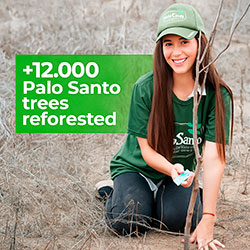
FREE SHIPPING - Palo Santo Incense Powder...

Manteño Chief Cone Incense Burner. The ceramic coner incense burner is made out of clay. Ceramic clay. Aprox. Measurements: Diameter: 7cm; Height 10cm. By burning a cone it is used to remove the bad energy from the home, away mosquitoes and insects, disinfects air.
Our Palo Santo is utilized in a sustainable way, that allows us a traceability from its planting, picking, transformation and commercialization.
PaloSanto’s properties: Bursera Graveolens PaloSanto Oil is a ecologically and sustainably harvested wood gathered on Ecuador's Pacific coast. This extraordinary aromatic tree is widely used in the traditional ethno-botanical systems of South America, especially by the shamans of the Andes.
This product is elaborated without harming the Palo Santo tree. We only process wood that has been found to have died naturally in the forest
Product of Ecuador
Ceramic incense burners manufactured by ecuadorian artisans. Retail & wholesale incense burner at EcuadorianHands.com - cone incense burners -
Product of Ecuador
The Manta culture.- The Manta culture (800-1530 AD) was established in the Ecuadorian coast in the southern province of Manabi, Guayas and extending to the island of Puna, in a variant known as Huancavilca culture. In general, the landscape is arid strip of coast, interspersed with strips moist, tropical climate hills to the East. Being seafaring peoples, it is almost predictable that the settlement patterns of maintenance has been by the sea. In fact, only in the areas of blanket and Salango, there is an appreciable penetration into the coastal hinterland, where they took advantage of their mountainous topography to locate their main centers, as is the case of Cerro de Cerro Jaboncillo sheet and, if not more than 200 m. height above the sea. The Manta culture was discovered in the early twentieth century, Marshall Saville who produced his monumental "Antiquities of Manabi", with extensive description of material culture, mainly from sites located in the hills above. Subsequently, in 1917 and 1923, and Caamano Jijón systematic excavations carried out in the same area, unable to publish the results thereof. Still, he managed to formulate for the first time, the constituent elements of the archaeological culture in his Anthropology Prehispdnica Manta in Ecuador, including the possibility of the existence of a similar culture in the province of Guayas. In the 1950s, Bushnell, Stirling, and Estrada was undertaken independently by further research, especially in the Guayas basin, with Estrada who would make the existence of the southern or Huancavilcas Manta, quite similar to their northern neighbors, but with the except that the stone did not work. Finally, in the 1980s, the area of Agua Blanca was investigated by Colin McEwan, whose valuable contribution focused on the role of the chairs of stone steles and other anthropomorphic and zoomorphic figures in the creation of social order in the Andes cosmogony and in the maintenance and social organization arising from settlement pattern.

Product and customer service is 10/10!


Please sign in first.
Sign in